Quantities of lighting: luminous flux, light intensity, illuminance, brightness, brightness
1. Light flux
Luminous flux — the power of radiant energy, as judged by the light sensation it produces. Radiant energy is determined by the number of quanta emitted by the emitter into space. Radiant energy (radiant energy) is measured in joules. The amount of energy emitted per unit time is called radiant flux or radiant flux. Radiant flux is measured in watts. The luminous flux is denoted by Fe.

where: Qе — radiation energy.
The radiation flux is characterized by a distribution of energy in time and space.
In most cases, when they talk about the distribution of the radiation flux over time, they do not take into account the quantum nature of the appearance of radiation, but understand it as a function that gives a change in time of the instantaneous values of the radiation flux Ф (t). This is acceptable because the number of photons emitted by the source per unit time is very large.
According to the spectral distribution of the radiation flux, the sources are divided into three classes: with linear, striped and continuous spectra. The radiation flux of a source with a linear spectrum consists of monochromatic fluxes from individual lines:

where: Фλ — monochromatic radiation flux; Fe — radiation flux.
For band-spectrum sources, emission occurs in fairly wide spectral regions—bands separated from each other by dark gaps. To characterize the spectral distribution of the radiation flux with continuous and banded spectra, a quantity called the spectral radiation flux density is used

where: λ is the wavelength.
The density of the spectral radiation flux is a characteristic of the distribution of the radiation flux over the spectrum and is equal to the ratio of the elementary flux ΔFeλ corresponding to an infinitesimal section to the width of this section:

The spectral radiation flux density is measured in watts per nanometer.
In lighting engineering, where the human eye is the main receiver of radiation, the concept of luminous flux is introduced to evaluate the effective action of the radiation flux. Luminous flux is the radiation flux estimated from its effect on the eye, the relative spectral sensitivity of which is determined by the averaged spectral efficiency curve approved by the CIE.
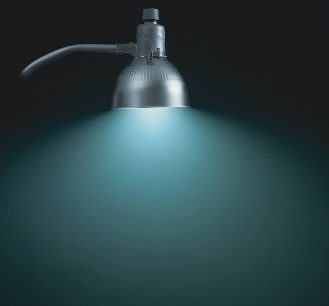
The following definition of luminous flux is also used in lighting technology: luminous flux is the power of light energy. The unit of luminous flux is lumen (lm). 1 lm corresponds to the luminous flux emitted at a single solid angle by an isotropic point source with a luminous intensity of 1 candela.
Table 1.Typical luminous values of light sources:
Types of lamps Electrical energy, W Luminous flux, lm Luminous efficiency lm / w Incandescent lamp 100 watts 1360 lm 13.6 lm / W Fluorescent lamp 58 watts 5400 lm 93 lm / W High-pressure sodium lamp 100 watts 10000 lm 100 lm / W Low pressure sodium lamp 180 watts 33000 lm 183 lm / W High pressure mercury lamp 1000 watts 58000 lm 58 lm / W Metal halide lamp 2000 watts 190 000 lm 95 lm / W The luminous flux Ф falling on the body is distributed in three components: reflected by the body Фρabsorbed by Фα and the missed Фτ... At lighting calculations utilization factors: reflections ρ = Fρ/ F; absorption α= Fα/ F; transmission τ= Fτ/ Ф.
Table 2. Light characteristics of some materials and surfaces
Materials or surfaces Coefficients Reflection and transmission behavior reflection ρ absorption α transmission τ chalk 0.85 0.15 — Diffuse Silicate enamel 0.8 0.2 — Diffuse Aluminum mirror 0.85 0.15 — Pointed Glass mirror 0.8 0 ,2 — Directed Frosted glass 0,1 0,5 0,4 Diffuse directed Bio milk glass 0,22 0,15 0,63 Diffuse directed Opal silicate glass 0,3 0,1 0,6 Diffuse Milk silicate glass 0, 45 0.15 0.4 Diffuse
2. Light intensity
The distribution of radiation from a real source in the surrounding space is not uniform.Therefore, the luminous flux will not be an exhaustive characteristic of the source if the radiation distribution in different directions of the surrounding space is not determined simultaneously.
To characterize the distribution of the light flux, the concept of the spatial density of the light flux in different directions of the surrounding space is used. The spatial density of the luminous flux, which is determined by the ratio of the luminous flux to the solid angle with the apex at the point where the source is located, within which this flux is uniformly distributed, is called the luminous intensity:

where: Ф — luminous flux; ω — solid angle.
The unit of light intensity is the candela. 1 cd.
This is the luminous intensity emitted perpendicularly by a blackbody surface element of area 1:600,000 m2 at the solidification temperature of platinum.
The unit of light intensity is the candela, cd is one of the main quantities in the SI system and corresponds to a luminous flux of 1 lm uniformly distributed in a solid angle of 1 steradian (cf.). A solid angle is the portion of space enclosed in a conic surface. A solid angle ω measured by the ratio of the area it cuts out of a sphere of arbitrary radius to the square of the latter.
3. Lighting
Illumination is the amount of light or luminous flux falling on a unit surface. It is denoted by the letter E and is measured in lux (lx).
The unit of illuminance lux, lx, is measured in lumens per square meter (lm/m2).
Illumination can be defined as the density of light flux on the illuminated surface:
Illumination does not depend on the direction of propagation of the light flux to the surface.
Here are some commonly accepted luminance indicators:
-
Summer, a day under a cloudless sky — 100,000 lux
-
Street lighting — 5-30 lux
-
Full moon on a clear night — 0.25 lux
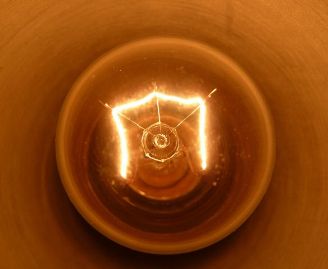
4. The relationship between light intensity (I) and illuminance (E).
Inverse square law
Illumination at a certain point on the surface, perpendicular to the direction of light propagation, is defined as the ratio of the light intensity to the square of the distance from this point to the light source. If we take this distance as d, then this ratio can be expressed by the following formula:

For example: if a light source emits light with a power of 1200 cd in a direction perpendicular to the surface at a distance of 3 meters from this surface, then the illumination (Ep) at the point where the light reaches the surface will be 1200/32 = 133 lux. If the surface is at a distance of 6 m from the light source, the illumination will be 1200/62 = 33 lux. This relationship is called the inverse square law.
Illumination at a certain point on a surface that is not perpendicular to the direction of light propagation is equal to the light intensity in the direction of the measurement point divided by the square of the distance between the light source and a point in the plane multiplied by the cosine of the angle γ (γ is the angle formed by the direction of light incidence and the perpendicular to this plane).
Therefore:

This is the law of cosines (Figure 1.).
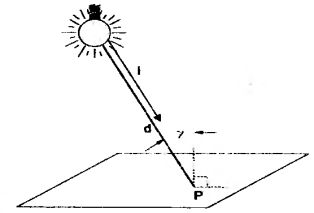
Rice. 1. To the law of cosines
5. Horizontal lighting
To calculate the horizontal illumination, it is recommended to modify the last formula by replacing the distance d between the light source and the measurement point with the height h from the light source to the surface.
Figure 2:


Then:

We get:

This formula calculates the horizontal illumination at the measurement point.
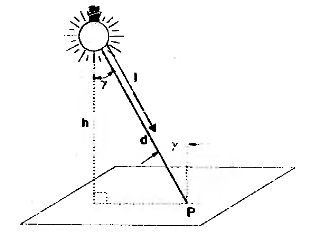
Rice. 2. Horizontal lighting
6. Vertical lighting
The illumination of the same point P in a vertical plane oriented towards the light source can be represented as a function of the height (h) of the light source and the angle of incidence (γ) of the light intensity (I) (Figure 3) .


We get:

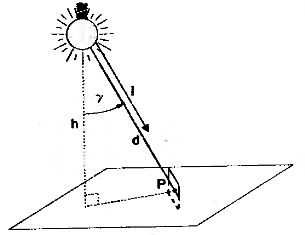
Rice. 3. Vertical lighting
7. Illumination
To characterize surfaces that glow due to the light flux passing through them or reflected from them, the ratio of the light flux emitted by the surface element to the area of this element is used. This quantity is called luminosity:

For surfaces with limited dimensions:

Illuminance is the density of the light flux emitted by the light surface. The unit of illuminance is the lumen per square meter of the light surface, which corresponds to an area of 1 m2 that uniformly emits a luminous flux of 1 lm. In the case of total radiation, the concept of energy luminosity of the radiating body (Me) is introduced.
The unit of radiant light is W/m2.
The brightness in this case can be expressed by the spectral density of the energy luminosity of the emitting body Meλ (λ)

For a comparative assessment, we bring the energy brightnesses into the luminosities of some surfaces:
-
Solar surface — Me = 6 • 107 W / m2;
-
Incandescent filament — Me = 2 • 105 W / m2;
-
The surface of the sun at its zenith — M = 3.1 • 109 lm / m2;
-
Fluorescent light bulb — M = 22 • 103 lm / m2.
8. Brightness
Brightness The brightness of the light emitted by a unit of surface in a certain direction. The unit of measurement for brightness is the candela per square meter (cd / m2).
The surface itself can emit light, similar to the surface of a lamp, or reflect light that comes from another source, such as a road surface.
Surfaces with different reflective properties under the same lighting will have different degrees of brightness.
The brightness emitted by the surface dA at an angle Φ relative to the projection of this surface is equal to the ratio of the intensity of light emitted in a given direction to the projection of the emitting surface (Fig. 4).
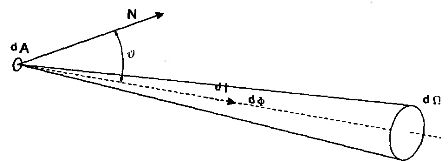
Rice. 4. Brightness
The intensity of the light and the projection of the emitting surface are independent of the distance. Therefore, brightness also does not depend on distance.
Some practical examples:
-
Brightness of the solar surface — 2,000,000,000 cd / m2
-
Brightness of fluorescent lamps — from 5000 to 15000 cd / m2
-
Surface brightness of a full moon — 2500 cd / m2
-
Artificial road lighting — 30 lux 2 cd / m2

